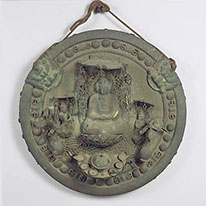Past Exhibitions
- Divine Reflections: Medieval Japanese Votive Mirrors and Plaques
- February 8, 2022 - March 13, 2022
Prior to the official introduction of Buddhism in the mid-sixth century, people in Japan worshipped local deities called kami. As Buddhism flourished, ritualists sought to clarify the relationship between the foreign buddhas and the native kami now associated with Shinto. A system known as "Kami-Buddhist combinatory thought" asserted that buddhas and kami were fundamentally identical, with local kami understood to be the temporary manifestations of transcendent Buddhist deities.
Such doctrinal interpretations influenced the creation of combinatory icons called mishōtai (kami bodies). These were formed from round votive mirrors and mirror-like plaques, symbolic receptacles of kami, which were combined with images of Buddhist deities that were either engraved (kyōzō) or affixed as three-dimensional sculpture (kakebotoke). Mishōtai functioned as objects of worship and visual manifestations of the divine.
This exhibit highlights the complex combinatory nature of medieval Japanese religious worship through a display of votive mirrors and plaques from the Heian through Muromachi periods.












